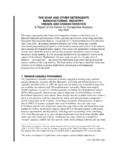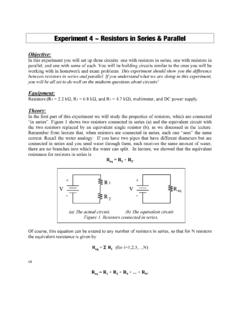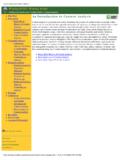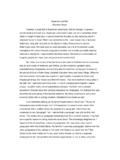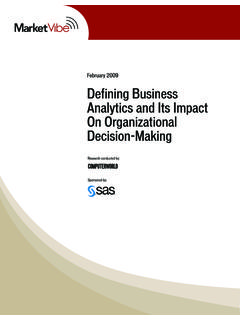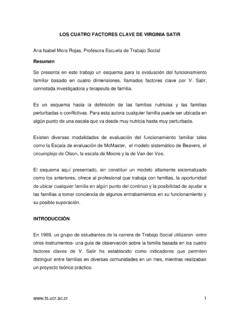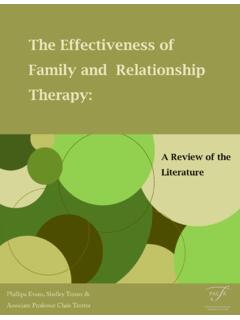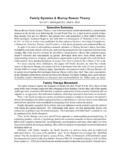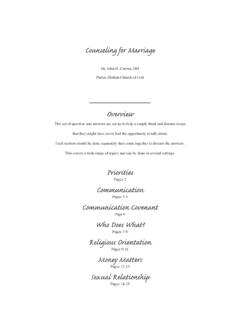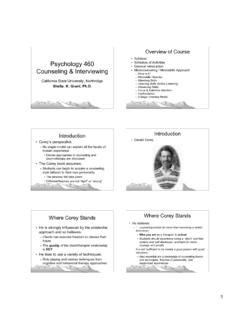Transcription of STUDY GUIDE: Licensed Clinical Social Worker Exam
1 1 STUDY GUIDE: Licensed Clinical Social Worker Exam 1. Important People 2. Important Theories 3. Group Therapy 4. Family Therapy 5. Medications 6. General Terms 7. DSM-IV 8. Best Practice/Treatment Ideas 9. Agency/Supervision Work 10. Growth & Development 11. Practice Evaluation & Utilization of Research 12. Professional Values & Ethics/Professional Relationships 13. History of Social Work 14. General Test Taking Advice I. Important People Piaget: Swiss psychology who created theory of cognitive development to explain the processes by which humans come to perceive, organize knowledge, solve problems and understand the world. According to this theory, human cognitive development is the product of a consistent, reliable pattern or plan of interaction with the environment, known as a scheme. Schemes are goal-oriented strategies that help the person achieve some intended result. These schemes are sensorimotor (occurring in infancy and early which, in which reflexes and motor responses are prevalent) and cognitive (based on experience and on mental images, reflecting the person s ability to develop the use of abstract reasoning and symbolism).
2 Erikson: German psychologist who worked in human psychosocial development theory. Created 8 stages of life. Karen Horney: Disputed penis envy, calling it both inaccurate and demeaning to women. Instead, Horney proposed that men experience feelings of inferiority because they cannot give birth to children. Masters & Johnson: Created sensate focus exercises, which focuses on progressive exercises, begins with non-genital touching only, leads to genital touching. Goal is to receive pleasure without pressure to perform and/or achieve orgasm. Jesse Taft and Virginia Robinson: Started functional theory. They attributed to the School of SW in PA and influenced the work of Mead, Dewey & Rank. This model was presented in contrast to the diagnostic school of thought (which was primarily psychoanalytic). Anna Freud: Started ego psychology Fritz Perls: Founder of Gestalt theory Mahler: Founder of object-relations theory Carl Rogers: Founder of client centered theory Pincus & Minahan & Garvin: Founders of systems theory Ackerman: Father of family therapy.
3 He primarily used a psychoanalytic approach, insight oriented Satir & Whitaker: Communications in family therapy. Mainly experiential (through experience), communication and humanistic, awareness of here and now leading to personal accountability, and increasing patterns of interaction. Satir focused on communication problems, double bind, faulty communication is caused by low self-esteem, and she was more of a practioner than a theoretician. Whitaker mostly operated with unconscious and discussed the transference phenomena. Generally communication family therapist acknowledges that intrapsychic factors can provide a foundation for family problems, but they do not try to interpret these factors. Family therapist who founded the emphasis in communication patterns are often referred to as the Palo Alto group 2 coming from CA. Strong emphasis on communication theory states that it is impossible to not communicate. Here emphasis is placed on behavior as communication and the communication inconsistencies that can occur.
4 Bowen: Worked with extended family systems, where rational processes are applied to better understand relationships (current and intergenerational) and to maximize self-differentiation. Discussed triangulation and the dysfunction can come through several generations. Here the therapist is a coach. Remember, often used in this approach are genograms and ecomaps. Psychodynamic family therapy: resolution of problems should include intrapsychic exploration & resolution of unconscious object-relationships internalized from early parent-child relationships. Minuchin: Structural family therapy where behaviors are established through changes in transactional patterns, rather than through insight (action comes before insight). Treatment seeks to restructure family unit maladaptive transactional patterns. He believed if you improve process that you improve the family. Techniques often used in this model include: direct confrontation of family behaviors and prescribing the symptom.
5 This model of family therapy is considered best for deriving specific outcomes. Haley: Strategic family therapy primarily utilizes communication theory, systems theory and behaviorism. Similar to structural, the emphasis is placed on action rather than insight. Here the therapist often joins the family and is active in forcing the family to respond differently to situations based on the presence of the therapist and making use of family symptoms to bring about change. Liberman: Focused on behavior family therapy & Social learning theory. Treatment is focused on changing behavior patterns. Here the traditions of behavior modification remain where behavior is maintained by consequences. Albert Bandura: Focus on motivational needs, drives and impulses and cognitions toward action or change are not enough. We are Social creatures and therefore must take into account Social environment - Social Learning theory. Pavlov: Classical model of conditions: relationship between a stimulus and a response is unlearned or prewired, emphasis on antecedents.
6 (drooling dog) Skinner: Operant model of conditions: learning and reinforcement, emphasis on consequences. (Rat & treat lever) 2. Important Theories Psychodynamic Theory: (Little or no free will). The assumption that unconscious cause lies behind every mental process is known as: primary process thinking, secondary process thinking, psychic determinism, consensual validation. Psychodynamic theory is predicated on the assumption that there is an unconscious which informs one s life. Psychic determinism the idea that personality and behavior are determined more by psychological factors than by biological conditions or current life effects. o ID The only component of personality that is around from birth. Entirely unconscious and includes instinctive & primitive behaviors. Source of all psychic energy, the primary component of personality. Strives for the immediate gratification of desires. o Ego responsible for dealing with reality.
7 Ensures that impulses can be expressed in a manner acceptable in the real world. Functions in the conscious, preconscious & unconscious mind. Based on the reality principle - strives to satisfy the id s desires realistically & appropriately. o Superego is our sense of right & wrong. Provides guidelines for making judgment. Emerges around age 5. Guilt is here. Two parts of the superego- The ego ideal: includes the rules & standards for good behaviors. These behaviors include those which are approved of by parental & other authority figures. The conscience: includes info about things that are viewed as bad by parents and society. These behaviors are usually forbidden & lead to bad consequences. 3 o Ego strength the ego s ability to function, despite dueling forces. o Psychosocial development Oral stage: birth 1 year. Most of the world is interacted with by the mouth. Issues can occur during weaning. Anal stage: 1- 3 years old.
8 Primary focus is controlling the bladder & bowel movements. According to Freud, inappropriate parental responses can result in negative outcomes. If parents take an approach that is too lenient, Freud suggested that an anal-expulsive personality could develop in which the individual has a messy, wasteful or destructive personality. If parents are too strict or begin toilet training too early, Freud believed that an anal-retentive personality develops in which the individual is stringent, orderly, rigid and obsessive. Phallic Stage: 3-6 years old. Child starts to discover the differences between male & females. Freud also believed that boys begin to view their fathers as a rival for the mother s affections. The Oedipus complex describes these feelings of wanting to possess the mother and the desire to replace the father. However, the child also fears that he will be punished by the father for these feelings, a fear Freud termed castration anxiety.
9 The term Electra complex has been used to describe a similar set of feelings experienced by young girls. Freud, however, believed that girls instead experience penis envy. Eventually, the child begins to identify with the same-sex parent as a means of vicariously possessing the other parent. For girls, however, Freud believed that penis envy was never fully resolved and that all women remain somewhat fixated on this stage. Latent period: 6-12, the latent period is a time of exploration in which the sexual energy is still present, but it is directed into other areas such as intellectual pursuits and Social interactions. This stage is important in the development of Social and communication skills and self-confidence. Genital: 12+ source of satisfaction: Genitals. Outcome sexuality become focused in mature, genital love and adult satisfaction. o Primary process thinking: is the language of the unconscious ( slips of tongue, dreams, associations, jokes and child s language and thought.)
10 Ego Psychology (psychodynamic theory): o Credited to the work of Ana Freud, Erikson and others 4 o Anna Freud s focus was on the healthy individual not the sick one. From this perspective basic drives are influenced by the environment and critical periods. o This model draws heavily from psychoanalysis and utilizes the effect of the conscious and unconscious o Based on scientific determinism: individuals are products of the past, understanding the past explains the present (you are determined by your past) o Ego psychology applied to practice: the individual adapts to the environmental context through: Suggestion: the therapist plants a seed or idea Abreaction in therapeutic context, strong emotions are discussed in regard to the issue and catharsis ( , the release of tension in a protected setting) is achieved. Manipulation therapist directly or indirectly influences the client to a plan of action. Clarification and interpretation: the therapist pinpoints significant themes, etc.
